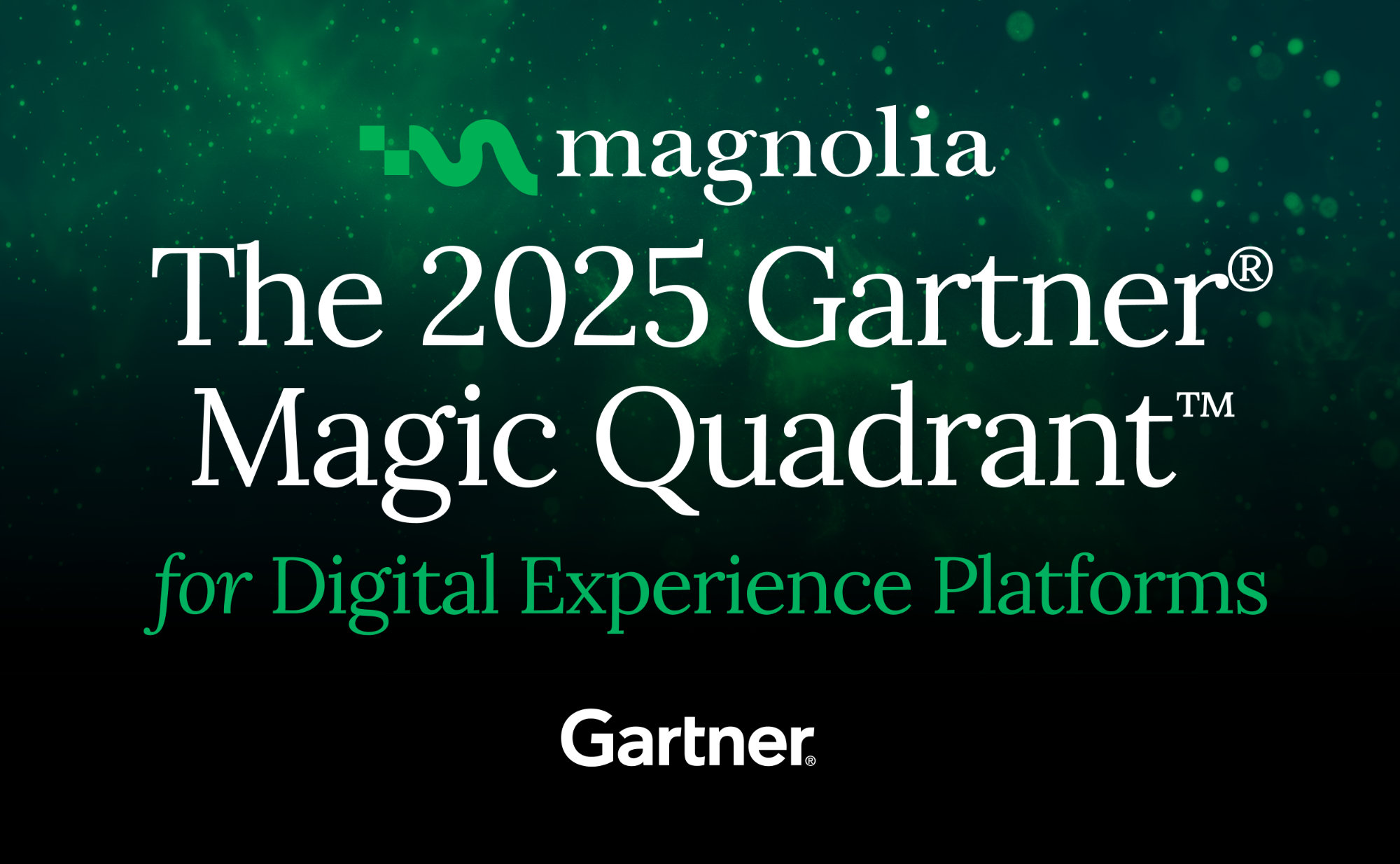- May 27, 2024
- 5 min
Digital transformation mistakes: One size doesn't fit all
Magnolia in action
Take 12 minutes and a coffee break to discover how Magnolia can elevate your digital experience.
In the past, business growth seemed to be the dominant measurement for success. Today, we’re slowly shifting toward agility. As startups and giant corporations alike seek to bolster their speed to respond to ever-evolving market demands, composable architecture offers a promising solution.
Composable technology enables interoperable, reusable components such as personalization engines, enterprise resource planning (ERP) systems or customer relationship management (CRM), content management systems (CMS), and customer data platforms (CDP) to form a cohesive and versatile tech stack.
However, this tech stack is complex and a common stumbling block arises when organizations search for a single, monolithic platform to manage it. This single-solution approach often leads to inadequate and siloed results, as no single system can expertly handle the full array of business processes and customer needs.
Instead, it’s wise to avoid this big mistake in modern digital strategy by recognizing the value of a composable business model that leverages a tailored blend of specialized technologies. Let’s discuss why.
3 Big mistakes in modern digital strategy - On demand
Learn from the experts the three big mistakes to avoid in modern digital strategy so you can make your decisions with clarity and confidence.
A composable digital experience platform is the perfect tool for your digital project
Given customers’ increasing expectations, your ability to adapt and tailor your resources defines your brand’s future success. A composable digital experience platform (DXP) is the ideal starting point for your projects, and the modular approach is its key advantage.
It doesn’t aim to cover every business capability or use-case scenario. Instead, it allows you to effortlessly embed other systems into your workflows, ensuring that you have a toolbox customized for your unique needs. You’re not restricted by the functionalities of a single suite; you can pick and choose the best tools for the job.
Consider security, for example. An effective composable DXP places high priority on safeguarding your business data and mitigates risks by integrating security strategies that protect your online presence. Meanwhile, it also allows you to add your own security measures, should your industry require them.
A plethora of vendors may claim to offer flexible, headless, and composable platforms. However, it’s paramount to examine their underlying architecture to fill that promise with meaning. Many parts of even prominent suites lack the necessary cohesion, potentially leading to integration headaches and reduced efficiency.
Tailor-made solutions are what a composable DXP delivers. By adopting an approach that embraces the power of a composable DXP, you’re choosing a method that advocates for technological agility — where components work in harmony, leading to a more holistic and effective digital presence.
Two philosophies: Monolithic integrations vs. the composable approach
When exploring digital architectures, you’re likely to encounter two distinct philosophies: monolithic integration and the composable approach. Monolithic architectures are akin to all-in-one suites, offering a singular, integrated platform with pre-built components. This model aims to streamline implementation and management but often at the cost of flexibility and adaptability.
Composable architectures, on the other hand, emphasize modularity and composability. By adopting a composable strategy, you can leverage independent modules and interchangeable components through APIs. This promising framework fosters efficiency and even lets you update generative AI models for content management as you adjust your workflows and policies.
In your journey to decide which strategy aligns with your objectives, consider how a composable architecture can yield a competitive advantage. With the rise of headless options and decoupled systems like Magnolia’s, your content management processes could become more dynamic, mirroring the philosophy of a decoupled CMS. The choice you make should accommodate not just current operational needs but also the potential for future growth and innovation.
Which architecture suits your business needs while providing the best digital experience?
As a decision maker, understanding which architecture best fits your business needs is crucial in enhancing your customers’ digital experience. A composable business offers scalability and flexibility by allowing you to handpick and interchange components that meet the current situation and recent customer requirements. This agility fosters resilience and adaptability, enabling you to respond to market demands rapidly and stay competitive.
In contrast, an all-in-one platform may appear as a comprehensive solution, but it can be more expensive, rigid, and limit your organization’s autonomy. Initially less costly, you might later uncover hidden costs due to isolated workflows that impede productive processes.
CIOs looking to secure their company’s digital investments should note that while suites offer a broad range of functions, their long-term maintenance and servicing come at a high cost, often requiring extensive specialist knowledge for even minor changes. By applying a composable approach to your supply chains and business architecture, you maintain governance while offering the needed autonomy to various departments.
A composable DXP breaks down silos and sets a foundational strategy for a user-centric experience, aligning with Gartner’s guiding principles. On paper, making the switch to a composable architecture might “just” save money, but the true value lies in the operational efficiencies and the streamlined experience for your customers.
How Magnolia approaches composable technology and agility
Magnolia has strategically embraced composable technology from its inception, emphasizing reusability and modular architecture. This approach allows you to tailor digital transformation initiatives by using a headless CMS that serves as a hub for various SaaS tools. Due to its composable nature, your technical debt is minimized, as you’re not locked into a single-vendor suite.
Your web development teams benefit from composable infrastructure, likened to Lego blocks, allowing seamless orchestration of packaged business capabilities. The building blocks of composable technology champion innovation, permitting rapid response to disruptions without sacrificing the agility of your operations.
With Magnolia, the focus on composable thinking extends to the backend, ensuring the discovery and integration of best-in-class services. Magnolia’s SaaS offerings synergize with your existing tools, augmenting the reusability of digital assets and streamlining production workflows.
It’s essential to note common pitfalls in digital strategy to ensure clarity in your decisions, as outlined by industry experts. By employing Magnolia’s composable DXP, you engage with a platform thoughtfully designed for the needs of editors and streamline your content management process.
Learn more about the building blocks of a digital marketing strategy
Avoid the trap of over-consolidation in digital marketing. Specialization is key: email marketing, social media, SEO, and PPC each need tailored tools.
Stay flexible to adapt swiftly to market changes; a composable approach allows quick tool swaps and saves costs by investing only in necessary features. Embrace innovation by integrating new tools easily.
Check out our webinar to explore these concepts further, and read up on the mistake of buying for today instead of tomorrow on our blog.










